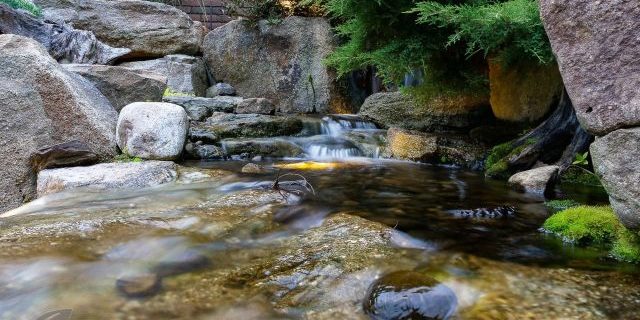
Four possible reasons your pond/waterfall is leaking:
Your approach to leak detection must be methodical, otherwise you might misdiagnose the cause and possibly waste a lot of time and money.
Water loss in a pond or waterfall usually can be attributed to the following four causes:Evaporation causes water loss in all bodies of water and must be considered.Edge leaks result when the liner edge gets pushed down, allowing water to leak over the berm. Cracked or broken pipes or fittings allow water to seep into the soil.Liner leaks occur when the rubber liner is punctured, cut, or chewed through.
To locate where and how your water feature is leaking, it is important to have a methodical approach. Rushing to fix a possible cause could be costly and ineffective.
Step 1: Measure and record water loss over a consistent time period.
The first step in identifying a leak is to record how much water your feature is losing in an easily observable timeframe. To begin, measure water loss while your feature is running. It is important to measure water loss from an accurate and predictable point. Watching the waterline on a rock or observing the apparent rate of a waterfall are not predictable measurements. If your pond has any type of autofill or fill valve that adds water to your pond, turn it off. Do not add any water to the water feature while measuring water loss!
The best way to observe water loss is by measuring from a set point. Inside the pump vault, or skimmer is usually the best place to do this. Observing water loss over 6-, 12-, or 24-hour periods is usually most effective. Write down your measurements! Try to be as accurate as possible with your measurements; knowing that your pond lost “about an inch” will not help you or a service technician when trying to find leaks.
Once you have a reliable rate of water loss, we can compare your water loss rates to evaporation rates. Evaporation during summer months can claim a large amount of water causing apparent “leaks.” Under normal conditions, a running water feature will lose between ½%-1% of the running water flow per hour in a day. If your pump pushes 3,000 gallons an hour, your water feature can lose between 15-30 gallons per day. A flow meter can be used to calculate how much water is required to refill the pond to its original level. If your pond is losing more water than average daily evaporation rates, it is time to start searching for leaks.
Step 2: Search for edge leaks around the stream and pond areas.
After ruling out evaporation, edge leaks are the next area to search. Edge leaks will occur most often in stream or waterfall areas. Look for damp or wet soil around the edges of your water feature. If you do find a place where water is running or leeching over the liner, this berm will need to be reworked. There should be enough extra liner buried in the soil to rebuild the edge high enough so that water cannot escape. Areas behind larger rocks or boulders can be prime locations for leaks if the liner gets pushed down behind them. If you can find and fix an edge leak on your water feature, you can begin measuring water loss again. If you don’t observe water loss after fixing the edge leak, congratulations! You have eliminated your leak.
If you complete these steps and your water feature is still losing water, it is time to shift attention to the pond (or basin, if you have a disappearing waterfall).
Step 3: Test the pond for leaks.
Turn off all pumps running the stream or waterfall and allow the pond to sit for a day. Carefully measure and observe the water level when the pumps are off and the water is resting. If the water loss is minimal or zero, this means that your leak is occurring in the stream or the plumbing. If your pond holds water, you are ready for the next step.
If the pond is losing water while it is not running, this probably means there is a puncture in the liner. Do not refill your pond. Allow the pond to drain until the water reaches a stable level (meaning the pond has drained to the level of the leak). If your pond drains completely, the puncture must be on the bottom. Take note of the water level before you begin searching the pond. If your pond is rock walled, this may require disassembling the rock walls and cleaning the liner in order to find the puncture.
Even a tiny puncture the size of the diameter of a pencil can drain over 100 gallons a day! Once the puncture is located, it will require a rubber liner patch kit. Follow the manufacturer’s requirements for using the patch kit. DO NOT attempt to seal the liner with any type of silicon, foam, or sealer. Most of these products are not fish safe and do not provide a permanent fix.
Step 4: Test the stream for leaks.
To find a stream liner puncture or hole, the water must continue to flow. To isolate the area of the leak, run a temporary pipeline from your pump to the first waterfall or shelf of your stream. Allow water to run normally through your temporary line for at least 24 hours. During this time, carefully monitor the water level. If you don’t observe any water loss, you can safely conclude that the bottom shelf or waterfall is leak-free.
Now, move your temporary pipeline upstream to the next waterfall or shelf. Again, monitor water levels while running the pump through this temporary line. Repeat this process step by step up the stream until you find an area that is losing water. Like a pond liner leak, locating a stream liner leak might require moving rocks and gravel. Use only an appropriate liner patch kit to seal and fix any punctures.
Step 5: Test for plumbing leaks.
If you have tested all areas of your stream and pond and are still recording significant water loss, your feature probably has a plumbing leak.
You might not see any wet areas on the surface since plumbing lines are usually buried at least several inches underground. While the pumps are pushing water through the line, dig along the pipe from the skimmer toward the head of the stream. Once you locate the leak, cut out the compromised section of pipe and replace it. DO NOT attempt to wrap the leaking pipe or fixture in tape, plastic, or any type of sealer. These fixes are meant only for temporary leak control and should only be used in an emergency until a proper repair can be completed.
Get Professional Help for Your Water Feature Leak
If you are still unable to locate or repair a leak in your water feature, or if you would like a professional to handle your leak dilemma, call us at 814-204-2721 or contact us online.
